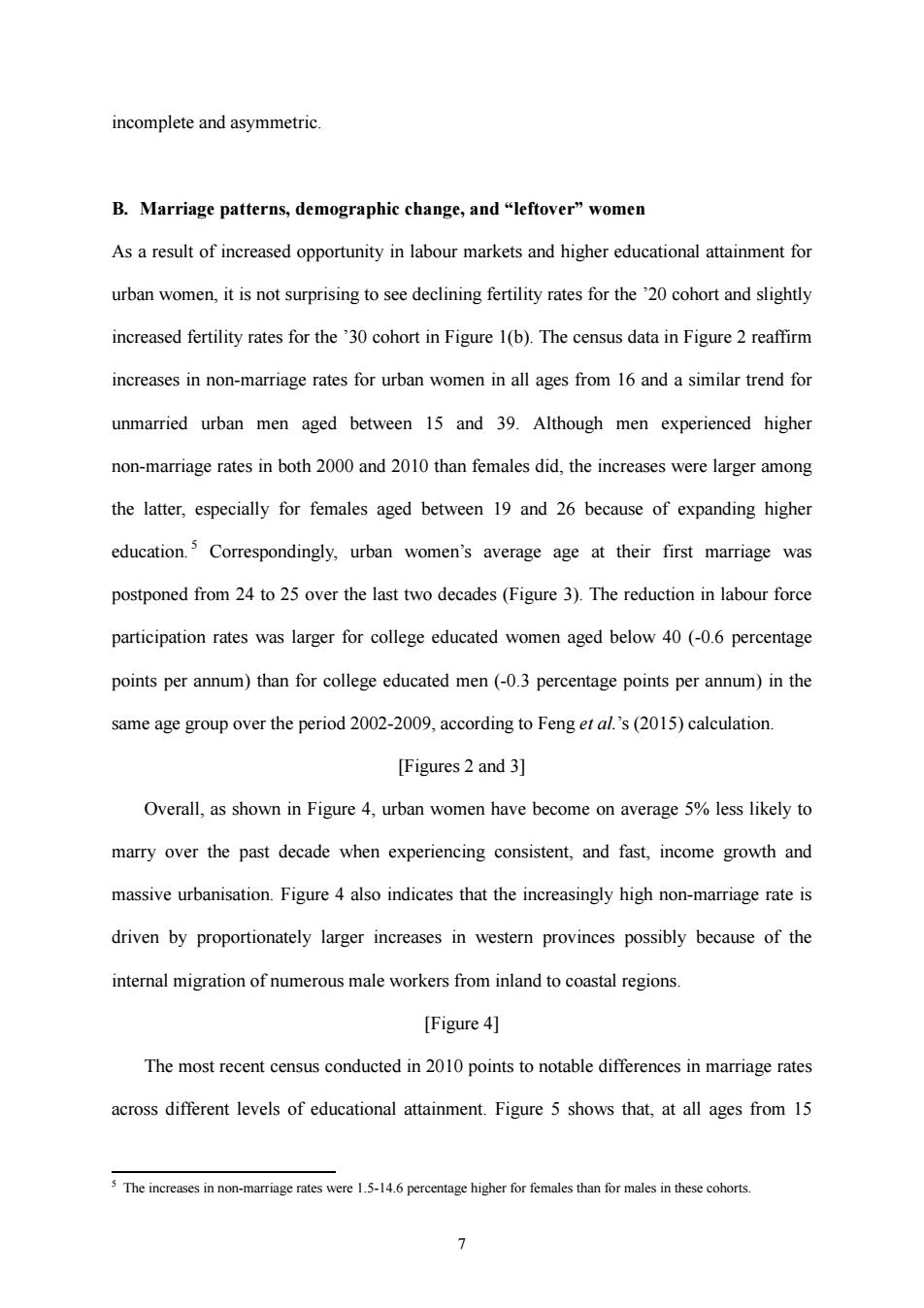正在加载图片...

incomplete and asymmetric. B.Marriage patterns,demographic change,and "leftover"women As a result of increased opportunity in labour markets and higher educational attainment for urban women,it is not surprising to see declining fertility rates for the'20 cohort and slightly increased fertility rates for the'30 cohort in Figure 1(b).The census data in Figure 2 reaffirm increases in non-marriage rates for urban women in all ages from 16 and a similar trend for unmarried urban men aged between 15 and 39.Although men experienced higher non-marriage rates in both 2000 and 2010 than females did,the increases were larger among the latter,especially for females aged between 19 and 26 because of expanding higher education.3 Correspondingly,urban women's average age at their first marriage was postponed from 24 to 25 over the last two decades(Figure 3).The reduction in labour force participation rates was larger for college educated women aged below 40(-0.6 percentage points per annum)than for college educated men(-0.3 percentage points per annum)in the same age group over the period 2002-2009,according to Feng et al.'s(2015)calculation. [Figures 2 and 3] Overall,as shown in Figure 4,urban women have become on average 5%less likely to marry over the past decade when experiencing consistent,and fast,income growth and massive urbanisation.Figure 4 also indicates that the increasingly high non-marriage rate is driven by proportionately larger increases in western provinces possibly because of the internal migration of numerous male workers from inland to coastal regions. [Figure 4] The most recent census conducted in 2010 points to notable differences in marriage rates across different levels of educational attainment.Figure 5 shows that,at all ages from 15 5 The increases in non-marriage rates were 1.5-14.6 percentage higher for females than for males in these cohorts. >7 incomplete and asymmetric. B. Marriage patterns, demographic change, and “leftover” women As a result of increased opportunity in labour markets and higher educational attainment for urban women, it is not surprising to see declining fertility rates for the ’20 cohort and slightly increased fertility rates for the ’30 cohort in Figure 1(b). The census data in Figure 2 reaffirm increases in non-marriage rates for urban women in all ages from 16 and a similar trend for unmarried urban men aged between 15 and 39. Although men experienced higher non-marriage rates in both 2000 and 2010 than females did, the increases were larger among the latter, especially for females aged between 19 and 26 because of expanding higher education. 5 Correspondingly, urban women’s average age at their first marriage was postponed from 24 to 25 over the last two decades (Figure 3). The reduction in labour force participation rates was larger for college educated women aged below 40 (-0.6 percentage points per annum) than for college educated men (-0.3 percentage points per annum) in the same age group over the period 2002-2009, according to Feng et al.’s (2015) calculation. [Figures 2 and 3] Overall, as shown in Figure 4, urban women have become on average 5% less likely to marry over the past decade when experiencing consistent, and fast, income growth and massive urbanisation. Figure 4 also indicates that the increasingly high non-marriage rate is driven by proportionately larger increases in western provinces possibly because of the internal migration of numerous male workers from inland to coastal regions. [Figure 4] The most recent census conducted in 2010 points to notable differences in marriage rates across different levels of educational attainment. Figure 5 shows that, at all ages from 15 5 The increases in non-marriage rates were 1.5-14.6 percentage higher for females than for males in these cohorts